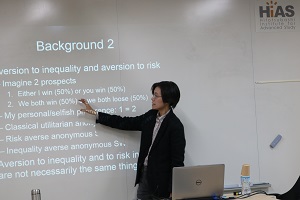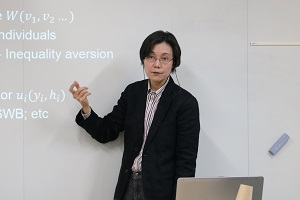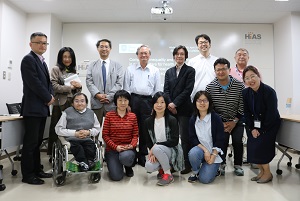英国シェフィールド大学の土屋有紀教授を講師にお迎えして、2018年4月6日(金)に定例研究会を開催しました。一橋大学国際交流セミナーを兼ねて開催された本定例研究会は、学外からの参加者を含む15名の参加を得、研究会および引き続き講師を交えた交流会の場で、活発な議論が交わされました。
 |  |  |
| 講演者を紹介する中村良太 HIAS Health 研究員(一橋大学社会科学高等研究院 准教授) | 講演中の土屋有紀教授 | 講演中の土屋有紀教授 |
 |  |  |
| 参加者からの質問に答える土屋教授 | コメントをする西村周三 HIAS Health 客員研究員(医療経済研究機構 所長) | 参加者と |
---------------------------
| 日時 | 2018年4月6日(金) 16:00-17:30 |
| 会場 | 西キャンパス 第2研究館 5階 HIASセミナー室(517号室) |
| 報告者 | 土屋有紀(つちや あき)、教授、 School of Health and Related Research (ScHARR) and Department of Economics、シェフィールド大学、英国 |
| タイトル | 「Comparing inequality and risk aversion in social welfare for health and income: an empirical analysis using hypothetical scenarios with losses」 |
| 言語 | 英語 |
| 概要 | Conceptually, two kinds of distributional preferences regarding social welfare can be distinguished from each other: inequality aversion and risk aversion. Each of these may depend on the domains of social welfare such as income or health. In this paper, four kinds of distributional preferences are elicited and compared: inequality aversion in health, inequality aversion in income, risk aversion in health, and risk aversion in income. Face to face interviews of a representative sample of the general public in Spain are undertaken using hypothetical scenarios involving losses in health or income across otherwise equal groups, over a limited duration of time. Aversion parameters are estimated assuming Social Welfare Functions with constant relative and constant absolute aversion. We find evidence suggesting that social preferences regarding aversions to inequality and to risk are not the same within the health or the income domain, nor across the two contexts: the results show statistically significant differences among the four distributional preferences, with inequality aversion in household income the strongest, followed by risk aversion in household income and risk aversion in individual health (between which no significant difference was found under constant absolute aversion though), and inequality aversion in individual health coming last. |

